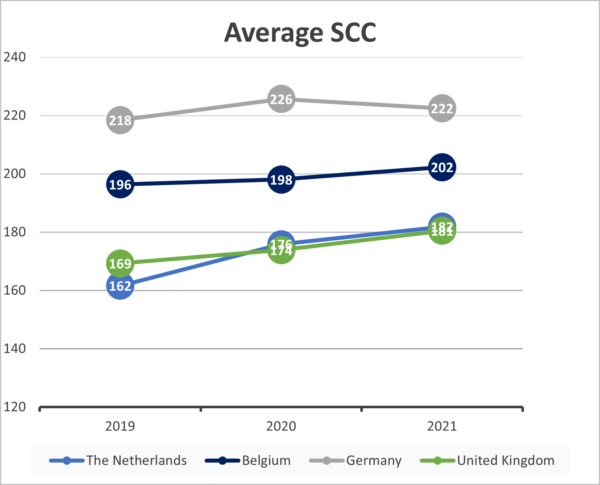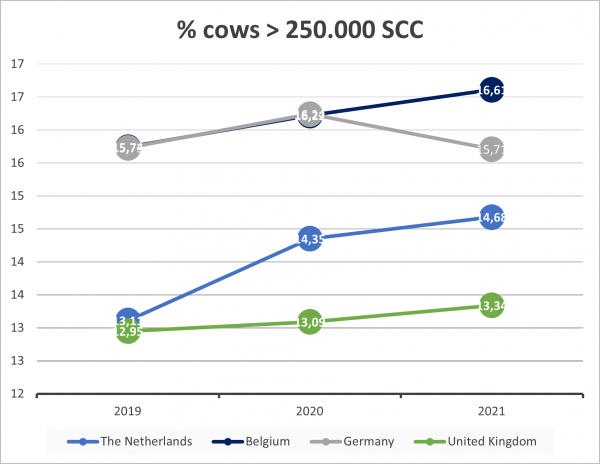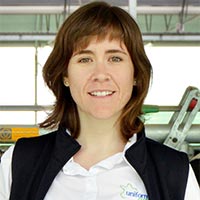Health analyses of dairy farms in the last 3 years in Europe
As in previous papers about farm comparison, the Dataset we use for these analyses and benchmark are a unique set of data from dairy farmers who all use the UNIFORM software for many years in 4 different countries. All the farmers participate in the farm comparison and send in their summary of data monthly. Anonymously these data can be used to analyze the situation in the 4 countries in this study. We are looking at a fixed group of farms in the 4 countries who join this farm comparison for minimum 3 years in a row. The data in the graphs shown are the average values in January of each year. The countries are the Netherlands (1420 farms), Belgium (299 farms), Germany (170 farms) and UK (480 farms).
In this chapter we focus in herd health. The analysis has been done in udder health indicators for dairy cows: Average somatic cellcount and % of cows with more than 250.000 SCC.
We know there are other important diseases and animal welfare indicators in a dairy farms, like lameness incidence and prevalence, or transition period diseases. But in this benchmarking we analyze udder health KPIs because these are managed as part of what is called in UNIFORM “the country link”. Therefore, all farmers have to manage and report data about udder health of the milking cows. In many places the data management and communication with national milk recording organizations and governements is directly made from the program on farm. The collected health data in this benchmarking is very accurate.
On the other hand, quality of diseases incidence and prevalence relies on the routines and bias in every farm. As a result data are more heterogenous and, therefore, not included in this farm comparison analysis.
Average Somatic Cell Count (SCC):
Somatic cell count simply measure the number of cells in the milk; the higher the somatic cell count the greater the chance that there is an infection. Uninfected cows usually have a SCC lower than 100.000/ml, and almost always have a SCC <200.000/ml. For the average SCC in bulk tank, same logic applies. In some places and farms, the threshold used to determine a healthy herd is SCC <150.000/ml.

This graph shows that 2 of the 4 countries (United Kingdom and The Netherlands) in the benchmarking are, for the last 3 years, below 200.000 SCC. Which means that herds of these two countries have, on average, very good udder health. Belgium has always a value around 200.000 SCC.
This could be explained as a result of the regulations in antibiotic use control that are running since more than a decade in The Netherlands. Because the individual treatments with antibiotics are less used, farmers have been focusing their work in disease prevention and control.
Also, in the UK in recent years new regulations and audits to improve animal welfare have been implemented. This adds more pressure on farmers to manage better the health of their dairy cows. Prevention and control protocols are more and more common in UK farms too.
Percentage of cows with high SCC:
An average value is a handy indicator, but should not be used alone to monitor the herd. The reason why is not recommended to look only to the average value is because, for different distributions of data, the average could be the same. For any data plot, if data distribution is normal, average value is very accurate as an indicator, but if data distribution is not normal, with many low values and many high values, average could be same value as previous case, but real situation is way different. For this purpose, we also analyze the percentage of infected cows within a herd (cows with more than 250.000 SCC). This group of cows should be less than 20% of the herd. Used in combination with Average SCC, helps us montioring better the herds.
In the 2nd graph it is showed that, again, The Netherlands and United Kingdom have the lowest values.

Also, in all countries, the trend of infected cows is the same as the trend of average SCC: more or less stable for UK, increasing a bit for NL, increasing in last year for Belgium and decreasing in last year for Germany. For all countries, the percentage is lower than 20%, and even lower than 15%. Which indicates a proper control of udder infections in herds.
Summary
The analysis of these indicators shows us a clear trend in all four countries in improving animal health and welfare. Some years ago the focus in herd management was in improving reproductive performance, because of its relevance in productive life of dairy cows. Nowadays herd health and welfare are getting a bigger spot in farm management. Farmers and dairy sector professionals are more sensitive to this, because healthier animals will be more efficient in reproduction and milk production, more long-lived and will contribute to a more sustainable farming.




